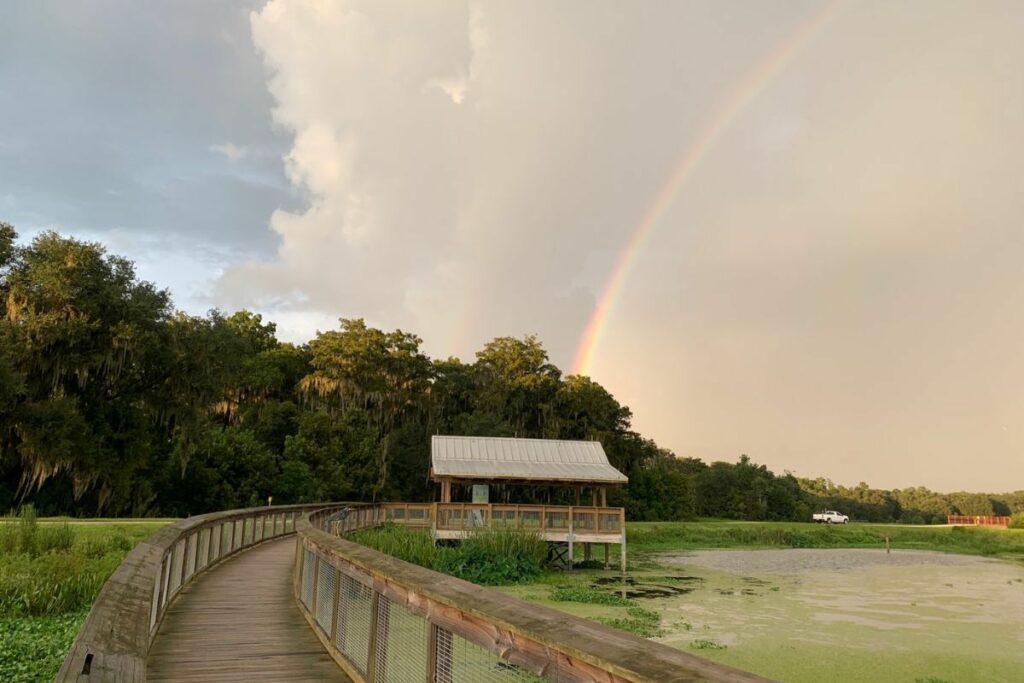
When you are driving down Southwest Williston Road in Gainesville, it’s easy to pass by Sweetwater Wetlands Park without even realizing you have done so. The entrance isn’t flashy and is very low-key.
There are no big signs proclaiming that the park is there, and if you blink, you could miss the entrance. So don’t blink, because if you do, you will miss a wonderful opportunity to explore nature with a purpose, literally in the middle of Gainesville.
“It is an enhancement wetland, about 273 acres, and in those acres, we have opportunities for wildlife viewing, plant viewing and for water treatment which is what the park was designed to do,” said Park Ranger Nathan Fox in our recent tour of the grounds.

The park opened to the public on May 2, 2015, and it has become one of the premier parks in Gainesville for people to visit. Although the park was designed primarily for water treatment, it has a lot of secondary effects as well for wildlife and plants.
“It serves the community interests and not just the human community. There is a sweet spot in the middle, that Sweetwater checks a lot of boxes for,” Fox said.
The park took about three years to build and was a cooperative effort that involved the city of Gainesville, the St. John’s Water Management District, Gainesville Regional Utilities (GRU), and the Audubon Society, with some assistance from the University of Florida as well.

Shaped like the head of an alligator, the park was designed to improve water quality by filtering out pollution and nutrients. It also provides other environmental benefits, such as restoring the natural water flow to more than 1,300 acres of formerly drained wetlands in Paynes Prairie and protecting and improving water quality in the Alachua Sink and the Floridan aquifer.
“An enhancement wetland is a man-made structure, a water system, that enhances the quality of the water that passes through it,” Fox said. “It is designed to remove specifically nitrates, the pollutants that are in the water that are from human use.”
The park was constructed as a sediment basin that collects the water and cleans it, from the area it serves. It all dumps into a concrete structure that is about an acre and a half in size, and never over ten feet deep, according to Fox.

But wait, wait, there’s more.
“The concrete pad collects large debris coming down during a flood event,” Fox said. “Couches, televisions, refrigerators, as well as large trees and logs, things like that. That is what it is designed to do.” We didn’t see anything like that on our tour, but when a hurricane or other big storm hits, anything’s possible.
The Sweetwater Branch Park Creek has its headwaters under the Publix on Main Street, flowing through Depot Park, Fox said. The water treatment facility on Main Street pours about 7 million gallons a day of effluent into the creek, water that’s been treated but still has a lot of nitrates.
In other words, there’s a lot of dirty water coming into Sweetwater Wetlands Park, but you would never guess it from a walkabout there.
We saw nesting turtles, snakes, ducks, rabbits, deer, and several baby alligators. “This sediment basin has been a kind of playpen for baby alligators,” Fox said. “The concrete lip allows baby alligators to go up, separating the little ones from the bigger ones.”
There’s a resident bobcat and for birders, this park is a paradise, with at last count, more than 255 species of birds spotted here. The park is among the top 10 birding locations in the southeastern United States.

“That’s pretty amazing. More birds are attracted here than any other inland county park in Florida. I call this place the field of dreams in some ways. Build it and they will come,” Fox said.
For humans, the best time to visit Sweetwater Wetlands Park, especially in the summer, is early morning or early evening. There is little shade here and the sun can be grueling.
Park rangers offer regular tours at least one Saturday and one Sunday a month on dates that can be confirmed on the park’s Facebook page. The Audubon Society also conducts bird walks on Wednesdays from 8:30 a.m. to 11 a.m. Again, exact dates can be determined on Facebook.
The park is open 365 days a year from 7 a.m. to sunset.
Admission is $5 per car or $2 per person for bicyclists, pedestrians, and bus passengers. An annual pass is available for $82 a year.

Suggested Articles
No related articles found.



